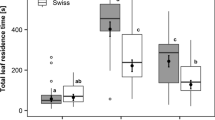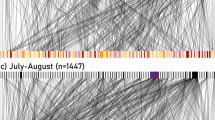Abstract
Population dynamics and variability were examined in one-host–two-parasitoid experimental systems with different resource distributions: resource-clumped and resource-sparse conditions. The system consists of a seed beetle host, Callosobruchus chinensis, and two parasitoid wasps, Anisopteromalus calandrae (Pteromalidae) and Heterospilus prosopidis (Braconidae). In the resource-clumped condition, suitable hosts for parasitism (the late fourth-instar larvae and pupae) were clumped in 1 large resource patch, but they were scattered evenly among 16 small patches in the resource-sparse condition. Population censuses were conducted at 10-day intervals in long-term cultures, renewing 10 g of azuki beans (Vigna angularis). In both resource conditions, the first period was a single-species system of C. chinensis only, and A. calandrae was added in the second period. The one-host–one-parasitoid system with C. chinensis and A. calandrae showed stable population dynamics with small fluctuations. After addition of H. prosopidis in the third period, two of three replicates persisted to day 800 in each resource condition, although one replicate in each went to extinction at an immediate outbreak of the H. prosopidis population after the introduction. Population variabilities of C. chinensis and H. prosopidis were significantly higher and the mean population size of A. calandrae was significantly smaller in the resource-sparse condition than that in the resource-clumped one. A short-term experiment on parasitism efficiencies revealed that H. prosopidis parasitized significantly more at a low host density in the resource-sparse condition than in the resource-clumped one. Mutual interference of H. prosopidis was weak enough at low parasitoid densities but became abruptly stronger with high densities. Providing fresh hosts in a mixture of already parasitized ones, host-searching behaviors of a parasitoid were recorded by video for 3 h and were compared between the two wasp species. H. prosopidis could parasitize fresh hosts more efficiently than A. calandrae through frequent long-distance walks (walking to distant beans at one bout or outside a clump of beans with hosts and back soon on a distant bean of the clump) after reencounters with parasitized hosts. Considering all the experimental results, populations were judged to be more fragile and more likely to go to extinction in the resource-sparse condition than in the resource-clumped one. A higher attacking efficiency of H. prosopidis destabilized population dynamics more in the resource-sparse condition.
Similar content being viewed by others
Author information
Authors and Affiliations
Additional information
Received: December 23, 1998 / Accepted: January 20, 1999
Rights and permissions
About this article
Cite this article
Shimada, M. Population fluctuation and persistence of one-host–two-parasitoid systems depending on resource distribution: from parasitizing behavior to population dynamics. Res Popul Ecol 41, 69–79 (1999). https://doi.org/10.1007/PL00011984
Issue Date:
DOI: https://doi.org/10.1007/PL00011984




